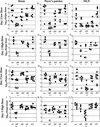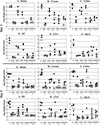Requirement of the Yersinia pseudotuberculosis effectors YopH and YopE in colonization and persistence in intestinal and lymph tissues
- PMID: 12874339
- PMCID: PMC166012
- DOI: 10.1128/IAI.71.8.4595-4607.2003
Requirement of the Yersinia pseudotuberculosis effectors YopH and YopE in colonization and persistence in intestinal and lymph tissues
Abstract
The gram-negative enteric pathogen Yersinia pseudotuberculosis employs a type III secretion system and effector Yop proteins that are required for virulence. Mutations in the type III secretion-translocation apparatus have been shown to cause defects in colonization of the murine cecum, suggesting roles for one or more effector Yops in the intestinal tract. To investigate this possibility, isogenic yop mutant strains were tested for their ability to colonize and persist in intestinal and associated lymph tissues of the mouse following orogastric inoculation. In single-strain infections, a yopHEMOJ mutant strain was unable to colonize, replicate, or persist in intestinal and lymph tissues. A yopH mutant strain specifically fails to colonize the mesenteric lymph nodes, but yopE and yopO mutant strains showed only minor defects in persistence in intestinal and lymph tissues. While no single Yop was found to be essential for colonization or persistence in intestinal tissues in single-strain infections, the absence of both YopH and YopE together almost eliminated colonization of all tissues, indicating either that these two Yops have some redundant functions or that Y. pseudotuberculosis employs multiple strategies for colonization. In competition infections with wild-type Y. pseudotuberculosis, the presence of wild-type bacteria severely hindered the ability of the yopH, yopE, and yopO mutants to persist in many tissues, suggesting that the wild-type bacteria either fills colonization niches or elicits host responses that the yop mutants are unable to withstand.
Figures






References
-
- Andersson, K., N. Carballeira, K. E. Magnusson, C. Persson, O. Stendahl, H. Wolf-Watz, and M. Fallman. 1996. YopH of Yersinia pseudotuberculosis interrupts early phosphotyrosine signalling associated with phagocytosis. Mol. Microbiol. 20:1057-1069. - PubMed
-
- Autenrieth, I. B., and R. Firsching. 1996. Penetration of M cells and destruction of Peyer's patches by Yersinia enterocolitica: an ultrastructural and histological study. J. Med. Microbiol. 44:285-294. - PubMed
-
- Barz, C., T. N. Abahji, K. Trulzsch, and J. Heesemann. 2000. The Yersinia Ser/Thr protein kinase YpkA/YopO directly interacts with the small GTPases RhoA and Rac-1. FEBS Lett. 482:139-143. - PubMed
-
- Black, D. S., and J. B. Bliska. 2000. The RhoGAP activity of the Yersinia pseudotuberculosis cytotoxin YopE is required for antiphagocytic function and virulence. Mol. Microbiol. 37:515-527. - PubMed
Publication types
MeSH terms
Substances
Grants and funding
LinkOut - more resources
Full Text Sources
Other Literature Sources

